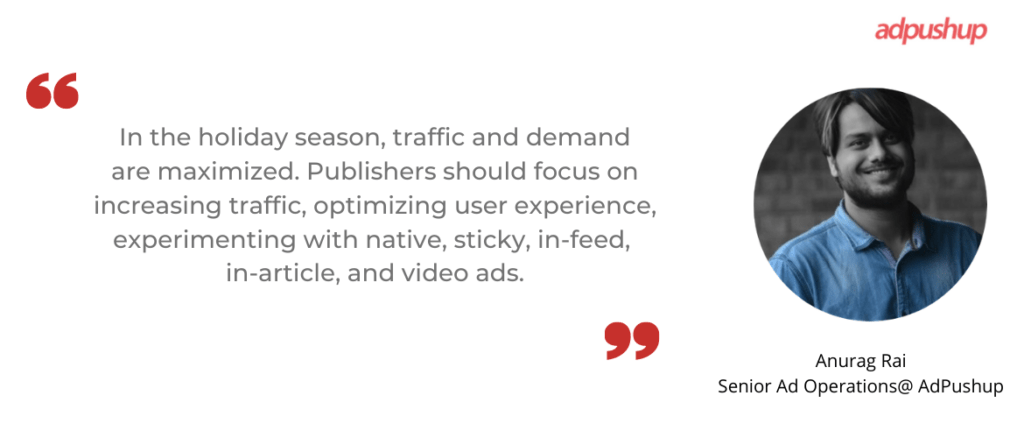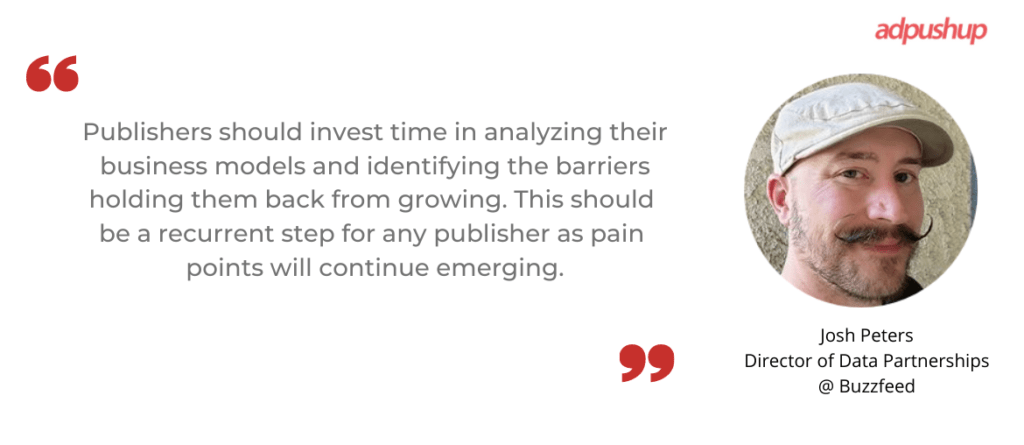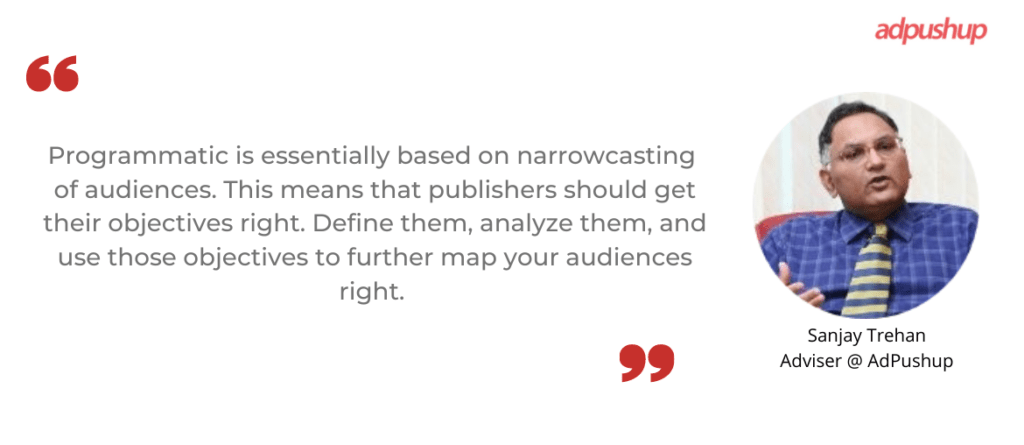We recently wrote about how publishers can optimize their Q4 revenue by following some tips that work for everyone.
However, since Q4 is spread across three months, we wanted to specifically focus on a particularly important section: the Holiday season.
Some of the most important holidays and occasions fall in the last three months of any year: Halloween, Christmas, Black Friday, New Year’s Eve, etc.
It’s an incredible time for publishers because people are frantically searching for information online driving more traffic to websites. Moreover, advertisers also consider this a lucrative time to inject more money into their campaigns.
Put together, the holiday season is a very optimistic time for everyone: publishers, advertisers, and users.
So how do you go the extra mile and make sure that you milk the last possible drop of profit out of the holiday season? For starters, you can follow the following tips. We have created a three-step strategy for publishers to ensure that they make the most out of the holiday season.
Bonus: Five specific tips for publishers still struggling with the negative impacts of COVID-19. Read till the end to find out!
Step 1: Leverage Technical Optimizations
One of the things that we recommend is leveraging technical changes in the existing setups. The holiday season is a good time to make powerful changes to your ad stack and see the impact they can have. Here are some technical optimizations that publishers can make.
1. Optimize Price Floors
Advertisers will bring in major demand during the holiday season. Capitalizing on this factor can help in earning a higher revenue. There are three kinds of price floor optimizations that publishers can make right now:
- Increase floor price: Some of the key dates in this quarter are great to increase your price floors, such as Black Friday, Halloween, etc. Whenever e-commerce stores have a big sale, immediately increase your floor price. Also, keep the price floors dynamic (constantly changing according to incoming bids) instead of static. Small increments over a span of week should do the trick. More information can be found here: What Should I Consider While Setting Floor Prices?
- Unified Pricing Rules: Publishers should carefully look at their unified pricing rules during the holiday season. Publishers should consider modifying their price floors if a large number of incoming bids are above the unified pricing rules. All this information can be found on the Pricing Rules card.
- Use Target CPM:. Target CPM is a smart feature that dynamically adjusts your unified pricing rules based on the incoming bids. The inventory pricing is also consistently maintained because the winning bids can be more or less than the target CPM, but the average CPM is always more or equal to the target price entered. Publishers should use this as it takes away the responsibility of adjusting price floors from them. With the entire process automated, publishers can shift their priorities to other important tasks.
2. Use More Viewable Ad Formats
In most cases, your website will receive quality traffic during the holiday season. If that happens, you need to make sure that you’re making all the possible profit in any user session, without compromising on their website experience.

What’s the best way to do that? Use ad formats that guarantee better ad viewability. Here are some that we recommend:
- Sticky Ads: Sticky ads are anchored to the screen i.e. constantly in the view of any user. For example, a footer sticky ad on the mobile version of your website is a good way to get more viewable impressions. Our guide on running sticky ads will help you set them up.
- Outstream Video Ads: It’s high time all publishers (in their capacity) experiment with video ads. Video ads have the highest click-through rate of all ad formats and during the holiday season, they can be even more lucrative. Publishers can start by partnering with an ad platform that can provide outstream video ads (like AdPushup). These ads do not require an external video player and are easy to implement.
- Native Ads: Native ads are one of the few ad formats that even users like interacting with. They merge well with the content, often removing the element of distraction in the process. This reduces the possibility of bad user experience. Publishers can skim through our list of best ad networks that provide native ads in their stack.
3. Experiment with Open Bidding or Amazon TAM
Publishers who have been successful in earning through header bidding on their websites must try experimenting with Google’s Open Bidding and Amazon’s Transparent Ad Marketplace.
The holiday season is a good time to increase competition for your inventory. Open bidding and TAM are both server-side integrations, so there will be fewer latency issues. Publishers can read up more on this through our resources:
- How does Open Bidding Work in Google Ad Manager?
- Publisher’s Guide to UAM/TAM: Amazon’s S2S Header Bidding Solutions
4. Analyze Your Audience
We recently conducted a webinar with Buzzfeed on taking first-party data to the next level. You can watch the webinar but the crux of the talk lies in understanding that audience segmentation is incredibly important. Here are the 3 things publishers can do:
- Figure out whether you need a customer data platform or a data management platform. This will help publishers in managing their data. Buzzfeed used a DMP but based on your use case, the requirement could be completely different.
- Define core metrics/factors basis which you would be segmenting the audience. Some of the top factors are geography, device, traffic source, etc. Publishers can read more on this in our explainer on audience segmentation.

- Use Google Analytics to consistently track these metrics to identify more patterns in your audience. If you start this by the end of October, there will be more time to capitalize on in the remaining two months. Another important factor is that Google Analytics can be linked with Google Ad Manager and Google AdSense, helping you provide excellent reporting.
5. Reach Out to Your Ad Tech Partners
Another important holiday tip that publishers must remember is to contact their ad tech partners and work on a strategy to get the maximum out of the holiday season.
Every ad tech partner might have unique insights that can help in making actionable strategies with positive results. Some of the important questions that publishers can ask are:
- Which ad sizes have been performing the best recently?
- Who are some of the advertisers that have been consistently spending on your inventory lately?
- What were some key takeaways from the previous year’s holiday season?
Adding to that, we also recommend publishers to partner with ad tech partners with seamless tech support (like AdPushup).
Step 2: Focus on Bringing and Retaining More Traffic
Publishers can spend all their time on technical optimizations to increase their revenue. But if the website traffic is not promising enough, that is effort wasted.
Although publishers should work all year round to increase website traffic, the holiday season, in general, sees more traffic. Why does this happen?
- People engage in buying gifts and goods for their families and friends. This brings traffic to all kinds of websites, be it a review, local products, among other stuff
- People actively travel to different places such as home or holiday destinations. This is a great opportunity for travel and credit card websites
- Food-related websites, be it the ones with recipes or the ones with recommendations for restaurants all garner many visitors
Here are some statistics to prove our point:
- 8/10 holiday shoppers consider Internet recommendations before purchasing products
- According to SimilarWeb, in 2019, traffic to the top 100 shopping websites increased by 137% during the holiday season
- Black Friday online sales have consistently increased with every passing year. In 2018, UK recorded online sales on Black Friday at £1.49 billion
So that’s enough convincing about why it’s important to focus on increasing website traffic in the holiday season. The essential question is: how do you do it? Here are five tips:
6. Create Holiday Content
The first thing that any publisher must do during the holidays is create customized and in-depth content revolving around the most important holidays. It’s important to note that keywords around these topics can be very competitive, hence, spending a considerable amount of time in conducting keyword research can make a remarkable difference.
The key lies in figuring out how your domain is related to the holiday season. For example, sports publishers can focus on boxing day fixtures, upcoming transfer windows, how different teams and clubs are handling the holiday season, etc. Likewise, food-related publishers can focus on holiday-specific recipes, holiday traditions, etc.
In any case, holidays generally positively impact everyone, hence enough opportunities to create content.
7. Revive Old Holiday Content
There’s a good chance that you have already created holiday-specific content in the past. This is the best time to update it and make sure that it features on your homepage. Here are some general tips to follow:
- Focus on Trends: Look for Google Trends during the holiday season, especially in the region that you’re targeting. Make sure to include content related to that.
- SEO Updates: Make SEO-level updates to your content. Remember that Google’s Broad Core Algorithm updates are done periodically and if your content answers a user’s query best, you’ll be the winner of SERP rankings.
- Include Visual Content: Including more visual elements such as images, gifs, infographics, videos, etc. is pivotal to decreasing bounce rate. Make sure that your past content is revamped in this manner.
8. Analyze What Worked Last Year
There’s absolutely no harm in going back and analyzing what worked for you during the previous year’s holiday season. You can use several tools by Google to look for trends and areas to improve.
Also Read: Google for Publishers: An Overview of Google’s Products
Here are some things for the holiday season that publishers must look at:
- Geography: Figure out which areas did you receive maximum traffic from last year. Focusing on bringing traffic from that region, along with optimizing ad inventory for the same will be beneficial.
- Particular Dates: Since there are many holidays in Q4, analyze exactly which dates worked well for you traffic-wise. Make sure that you especially optimize your content and site user experience around that time.
9. Don’t Skip on Promotions
Creating and reviving content is only half the job done. The latter half must revolve around promoting this content. The great part about this is that through promotions, you will get access to first-party data that you can use to improve your overall performance.
Collaborate with your paid and social team to create holiday-specific copy and ads to promote your content. You can further use this data to optimize your ad inventory.
Analyzing your audience will give you the opportunity to segment it and create ad placements that have a higher chance of a conversion.
10. Improve Site’s User Experience
Bringing in more traffic isn’t enough. Retaining the incoming traffic is also pivotal to higher revenue. Here are some general tips to do that:
- Decrease Page Load Time: Research has shown that users tend to stay less than 15 seconds on a website. Now imagine how important those 15 seconds are for you. If your website or ads do not load within those seconds, you’ll lose a user to another website.
Also Read: 5 Quick Optimizations to Help Reduce Page Latency
- Optimize for Mobile: More and more people are resorting to browsing the web on their mobile devices. Therefore, it makes sense to optimize your website for a mobile-first environment. We recommend publishers to go the extra mile and make use of trends related to the mobile web such as Accelerated Mobile Pages and AMPHTML Ads.
Some other tips that will always work for improving user experience are:
- If you’re creating a holiday-specific site structure, make sure it’s in alignment with your website’s primary design
- Audit your website for any malicious redirects that could be ruining the user experience
- Make sure there’s a healthy balance between ads and content. You can try adhering to the 30% ad density rule for mobile devices

Step 3: Recovering from COVID-19’s Impact
In March 2020, when nearly the entire world had begun reeling from the effects of the global lockdown, we listed down the unintended side effects of COVID-19 on publishers.
The bad news is that full recovery from that is still pending. The good news is that the ad tech industry is fully committed to this recovery.
The great news is that if you follow the tips below, recovery will be much faster.
11. Focus on Local Content
Local news and information got a major boost in traffic this year. General anxiety related to COVID-19 and lack of information about the novel virus made people search online for information.
Even right now, many cities across the world are undergoing periods of lockdown. Hence, people are turning to the Internet for getting any possible information. In fact, Google’s Search Liaison head has admitted to surfacing more local news for meeting the massive search-demand this year.
This is the best time for publishers to see what’s trending in their local region and create content around it. Backed by Google’s algorithm, this is a great opportunity to increase website traffic.
12. Check Inventory for COVID-19 Based Inappropriate Ads
2020 has seen an increase in malvertising. With advertisers pulling out budgets and publishers reducing their floor prices, bad actors got the opportunity to serve inappropriate and malicious ads on publishers’ inventory.
According to Clean.io, automotive and education publishers were the worst hit by COVID-19 malvertising. Moreover, they’ve also predicted a 152% increase in malvertising during Q4.
Also, regulators around the world are constantly creating laws to regulate inappropriate ads on publishers’ inventory. The UK government especially banned many kinds of ads this year including ads that claim IV drips can cure COVID-19, gambling ads with celebrities, ads for junk foods, etc.
Publishers can definitely prevent inappropriate ads from hurting revenue.
Also Read: How to Remove Malvertising: Key Practices to Follow
13. Run Direct Deals
Publishers should continue to focus on direct deals for getting the majority share of their revenue this year. The reasons for that are:
- More control over inventory specifications. In programmatic auctions, it is not possible to regulate every ad that is displayed. However, direct deals offer the flexibility to work with advertisers for more responsible but profitable advertising.
- Publishers can also avoid losses caused by keyword blacklisting by focusing on direct deals as they allow you to regulate campaigns.
14. Avoid Policy Violations Completely
COVID-19 brought with it the problem of keyword blacklisting for all publishers. Even though this problem has existed for quite some time, it got maximized this year.
Monetizing content on ‘COVID-19’ or ‘coronavirus’ became impossible and almost all publishers lost out on revenue. In that case, now when the traffic is returning and publishers have the upper hand, we recommend them to avoid policy violations at any cost.
We recently wrote about shadow blocklisting. That’s just one of the consequences of ignoring policy violation warnings from Google.
Hence, it’s better to avoid policy violations at all costs. Publishers can refer to these resources:
- Policy Violations in Google Ad Manager: How to Prevent and Resolve
- We Found Some Policy Violations on Your Site: What to do Next?
15. Make Sure to Identify Premium Ad Placements
Imagine you’re a seller of goods and someone comes asking you about your best available stock. If you don’t know anything about it, it leaves a bad impression.
Premium inventory works the same way. It’s the best possible ad unit(s) present on your entire ad inventory. How do you identify these placements? Run a/b testing using many parameters and you’ll have your answer.
The advantage is this year advertisers are particularly looking at the best possible ad placements available for earning high CPMs. It’s the holiday season and overall earnings due to COVID-19 have been low. Hence, it makes sense for publishers to do run tests for identifying premium ad placements.
Final Thoughts
We recognize that the above list is long and requires a lot of effort in a short span of time. To publishers, all we have to say is capitalize on managed services.
For example, we wrote earlier in this blog that consulting your ad tech partner is a great tip to boosting revenue during these times. We recommend it again. Publishers can also see this time as a lucrative opportunity to partner with better ad networks providing a host of solutions, such as AdPushup.
We provide powerful reporting and seamless technical support that can help you in increasing your revenue.
Shift your ad inventory optimization load to us: book a demo!

Shubham is a digital marketer with rich experience working in the advertisement technology industry. He has vast experience in the programmatic industry, driving business strategy and scaling functions including but not limited to growth and marketing, Operations, process optimization, and Sales.
![15 Holiday Tips for Publishers [COVID-19 Specific Tips Included] Revenue Optimization](https://www.adpushup.com/blog/wp-content/uploads/2020/10/Holiday-tips-for-publishers-770x515.png)






